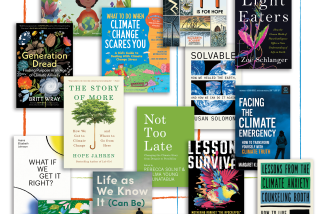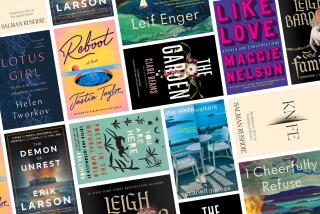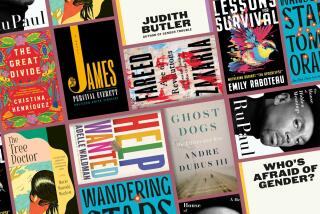Earthquakes in literature
Earthquakes are the expression of a living planet, the earth’s way of re-inventing itself. But while this knowledge may be consoling in the abstract, it’s not very useful in the face of a catastrophe such as the quake and tsunami in Japan. At these times, we need real consolation: food and water, emergency services and rescue ... and, David L. Ulin suggests, literature. Ulin is the author of “The Myth of Solid Ground: Earthquakes, Prediction and the Fault Line Between Reason and Faith.”
For as long as we have experienced seismicity, we have written about it, going back to the Book of Acts. Below are nine works that channel both our terror and our awe.
1) “The Earthquake in Chile” by Heinrich von Kleist.
Originally published in 1807, Kleist’s novella takes place during the 1647 Santiago earthquake and ends tragically, with a young couple killed after having been blamed, in a sermon, for the disaster. But Kleist has a bigger purpose, which is to highlight the idea that meaning is a matter of interpretation, that what we know is what we see. “[O]nly when he turned and saw the city leveled to the ground behind him,” he writes, “did he remember the terrifying moments he had just experienced. He bowed his forehead to the very ground as he thanked God for his miraculous escape; and as if this one appalling memory, stamping itself on his mind, had erased all others, he wept with rapture to find that the blessing of life, in all its wealth and variety, was still his to enjoy.”
2) “The Flutter of an Eyelid” by Myron Brinig.
Published in 1933, Brinig’s novel is the great modernist fantasy of Los Angeles (every city needs one), although it is essentially unread today. The book ends with a massive earthquake, in which the entire state of California breaks off from North America and crumbles into the Pacific, “Los Angeles toboggan[ing] with almost one continuous movement into the water, the shore cities going first, followed by the inland communities; the business streets, the buildings, the motion picture studios in Hollywood where actors became stark and pallid under their mustard-colored makeup.”
3) “The Folklore of Earthquakes” by Carey McWilliams.
Written in response to the 1933 Long Beach earthquake, McWilliams’ essay is a clear-eyed guide to both what we might call earthquake myths and the powerful terror the shaking provokes. “On the basis of their reaction to the word earthquake,” he writes, “Californians can be divided into three classes: first, the innocent late arrivals who have never felt an earthquake but who go about avowing to all and sundry that ‘it must be fun’; next, those who have experienced a slight quake and should know better, but who none the less persist in propagating the fable that the San Francisco quake of 1906 was the only major upheaval the State has ever suffered; and, lastly, the victims of a real earthquake -- for example, the residents of San Francisco, Santa Barbara, or, more recently, Long Beach. To these last, the word is full of terror. They are supersensitive to the slightest rattles and jars, and move uneasily whenever a heavy truck passes along the highway.”
4) “Ask the Dust” by John Fante.
In this 1939 novel, generally regarded as a cornerstone of the Southern California literary canon, Fante describes the struggles of a young man named Arturo Bandini, based directly on himself. In one particularly memorable set piece, Bandini survives the Long Beach earthquake, which he interprets as divine retribution for his sins. “You did it, Arturo,” he reflects. “This is the wrath of God. You did it.... Repent, repent before it’s too late. I said a prayer but it was dust in my mouth. No prayers. But there would be some changes made in my life. There would be decency and gentleness from now on. This was the turning point.”
5) “Quake” by Rudolph Wurlitzer.
Set in the late 1960s, in Hollywood, Wurlitzer’s 1974 novel is a phantasmagoria that unfolds across the landscape of a broken city, in which narrative, never solid to begin with, has deserted the survivors of a massive earthquake. “It’s going to be a long day,” one man says to another amidst the wreckage of the Tropicana Motel. “But if we’re not dead now we probably won’t be. I’m hemorrhaging or something. I’ll wait here. You forget me and I’ll come after you. Everything is in my wallet. Room six. I got credit cards.”
6) “Monster in a Box” by Spalding Gray.
In this 1990 monologue, Gray uses seismicity as a way to poke fun at Los Angeles and the city’s much-criticized lack of street life, after he has come here from New York to work on a film. ‘[T]he whole neighborhood is buzzing,” he tells us, describing the aftermath of an earthquake. “There’s a whole grapevine of conversation. Suddenly everyone is out there, talking. They’re all talking, talking, talking about the earthquake.... Then everyone stopped talking about the earthquake and went back to talking about their film scripts.”
7) “Annals of the Former World” by John McPhee.
Not about earthquakes per se -- although McPhee’s re-creation of the 1989 Loma Prieta quake is absolutely terrifying -- this is, instead, a deft, comprehensive and masterful geological history of North America: an account of the conditions, in other words, that underpin the world. “People look upon the natural world as if all motions of the past had set the stage for us and were now frozen,” McPhee writes, quoting geologist Eldridge Moores. “To imagine that the turmoil is in the past and somehow we are now in a more stable time seems to be a psychological need. ... [But] the time we’re in is just as active as the past. The time between events is long only with respect to a human lifetime.”
8) “Five Fires: Race, Catastrophe, and the Shaping of California” by David Wyatt.
In this 1999 book, Wyatt makes a case for fire as the central social shaping mechanism in California history, tracing five events in particular, including the Great San Francisco Earthquake and Fire of 1906. “With the earthquake and fire,” he writes, “San Francisco began the immediate translation of the text into the myth.... The particular story that San Francisco told itself about the earthquake and fire was of a city coolly eyeing its own destruction, a city acting ‘casual,’ as Kathryn Hulme describes a man blowing drifting char from his hands, ‘casual when you knew he wasn’t feeling so.’”
9) “After the Quake” by Haruki Murakami.
This 2000 collection of stories was written in reaction to the Kobe earthquake, which killed more than 6,000 people on Jan. 17, 1995. Although in many of the pieces here the disaster plays only a peripheral part, it reverberates throughout the book like an aftershock. “Five straight days she spent in front of the television,” Murakami writes in “UFO in Kushiro,” “staring at crumbled banks and hospitals, whole blocks of stores in flames, severed rail lines and expressways. She never said a word. Sunk deep in the cushions of the sofa, her mouth clamped shut, she wouldn’t answer when Komura spoke to her. She wouldn’t shake her head or nod. Komura could not be sure the sound of his voice was even getting through to her.”
More to Read
The biggest entertainment stories
Get our big stories about Hollywood, film, television, music, arts, culture and more right in your inbox as soon as they publish.
You may occasionally receive promotional content from the Los Angeles Times.











